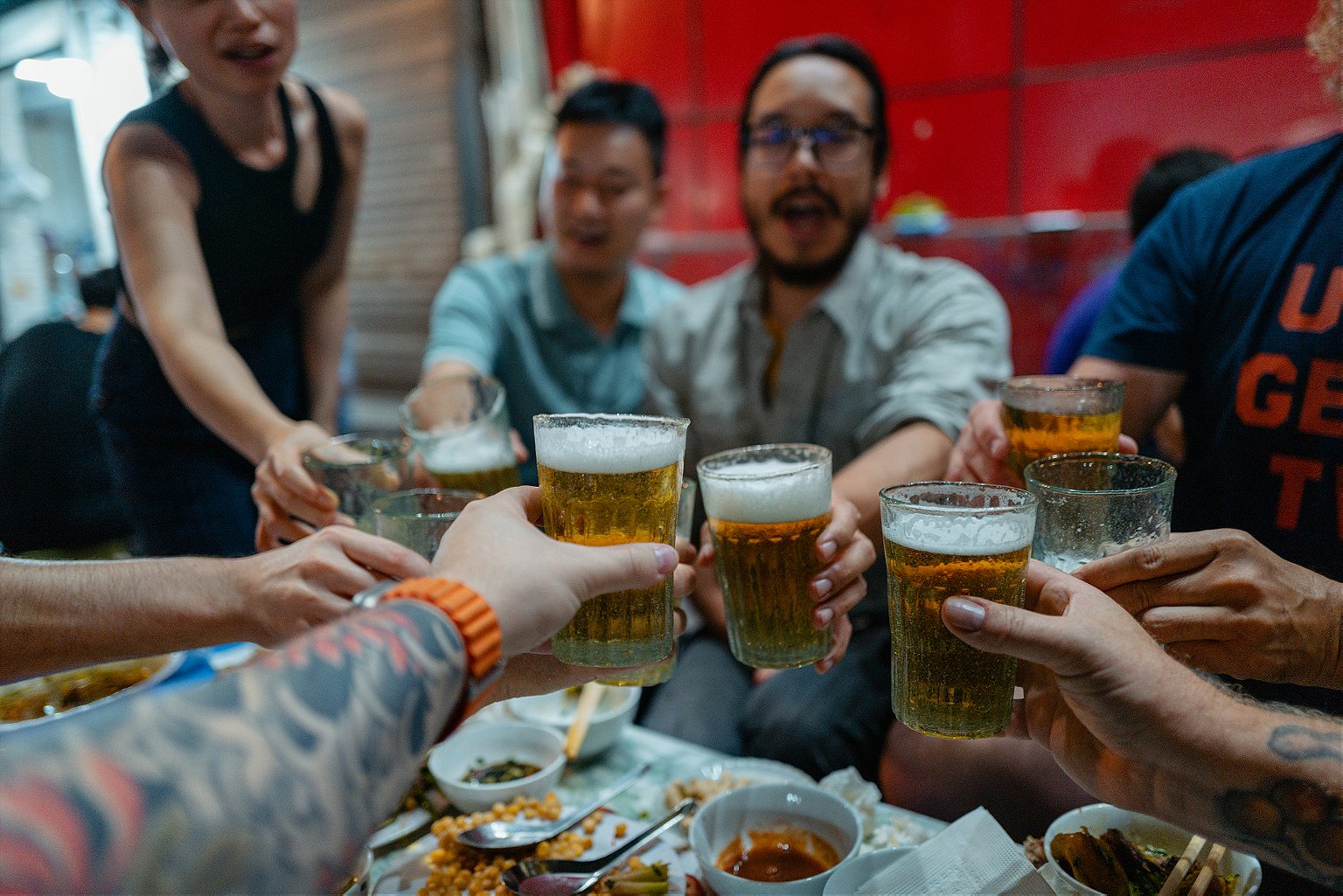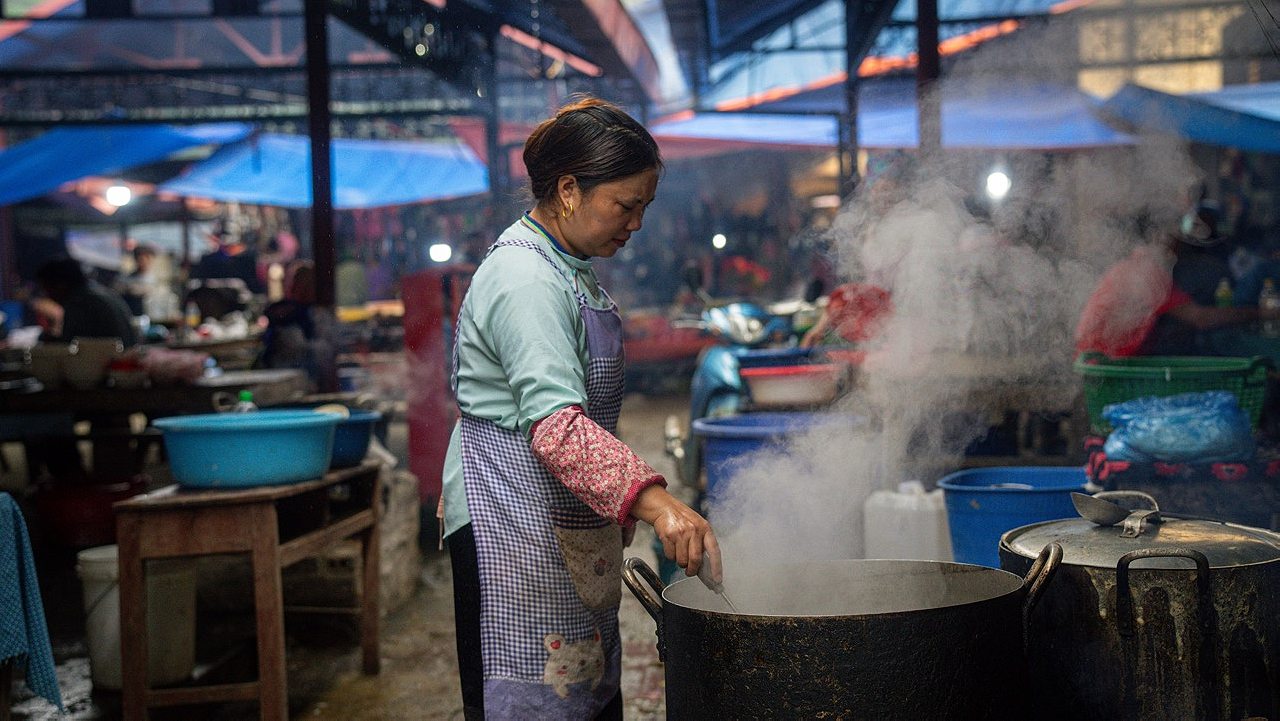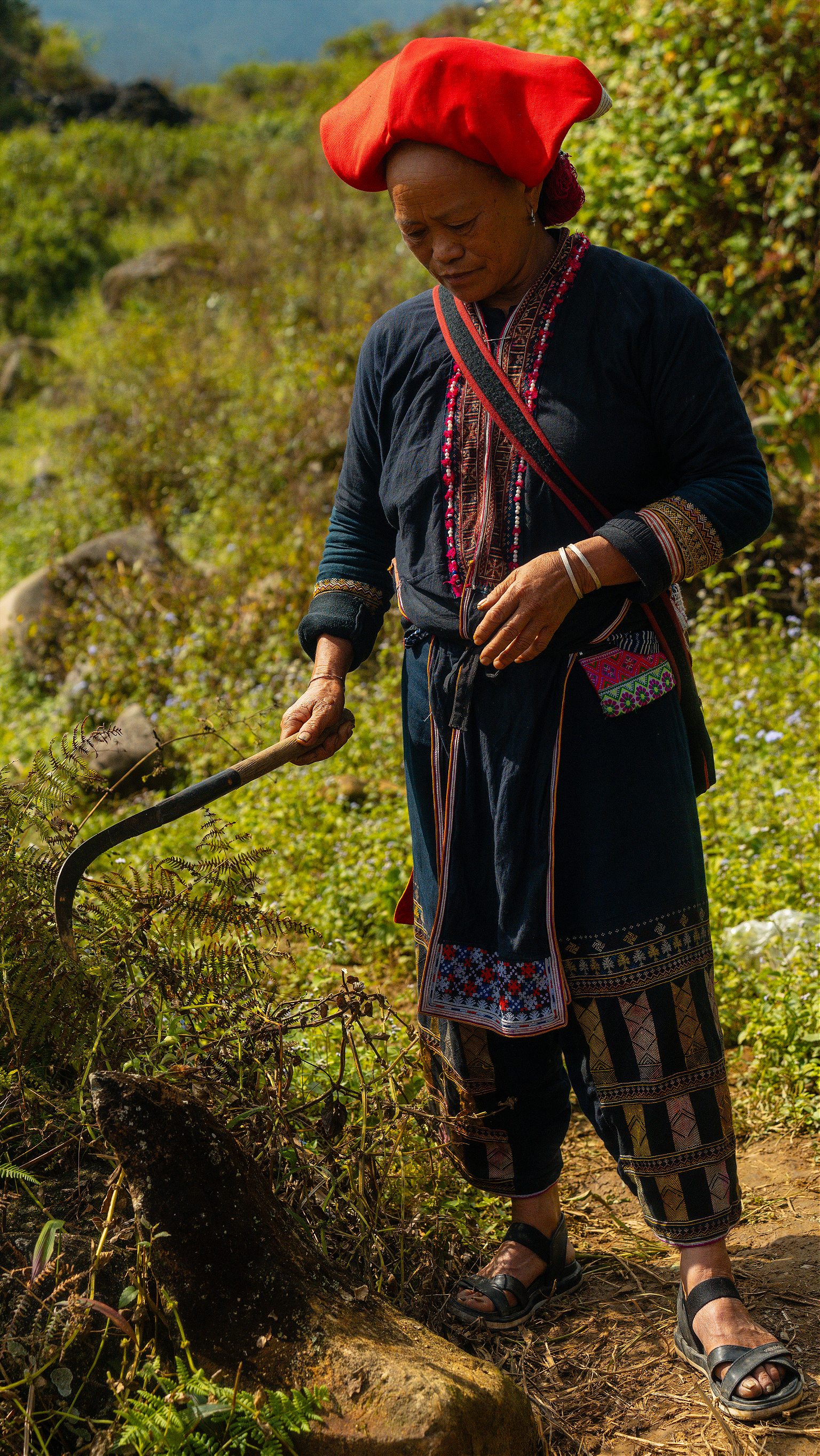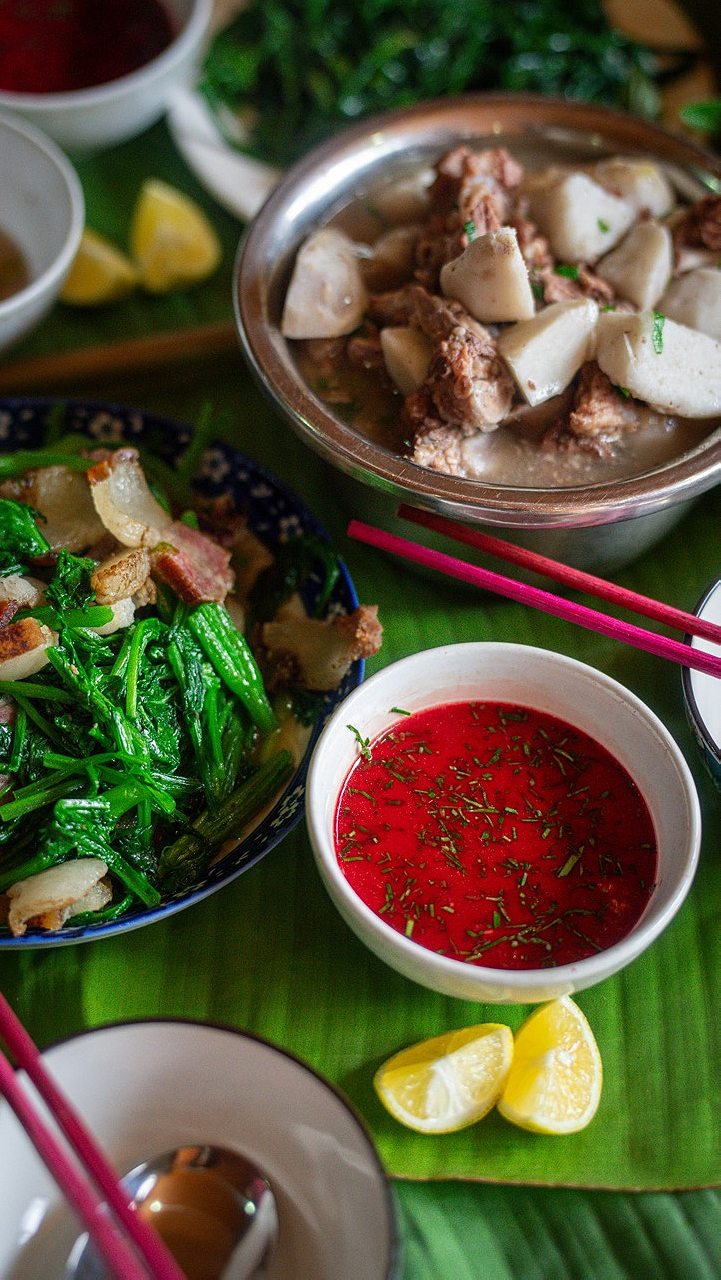Ahead of our League of Travelers trip to northern Vietnam in September, R&K’s Charly Wilder caught up with Daniel Nguyen, an activist, distiller, researcher, and our host for this fall’s journey into the highlands and beyond.
How has K-Pop influenced the dining scene of Hanoi? What can a red rice noodle dish in the mountains of northwest Vietnam tell us about the origins of phở? If you want to understand Vietnam’s present-day culinary landscape, you’d be hard pressed to find a more knowledgeable guide than Daniel Nguyen.
Raised in California by Vietnamese parents, Nguyen came to the country a decade ago to work with farmers in the Mekong Delta—part of his larger mission to use sustainable agriculture to help make communities more equitable. This work eventually led him to the founding of Sông Cái Distillery with his Hannoian partner—in business and in life—Nhung Trang Nguyen. The first entirely Vietnamese-owned endeavor of its kind, Sông Cái works with multi-generational foragers and farmers to source botanicals for a range of craft spirits, including the first gin ever distilled in the country.
Nguyen’s extensive work with farm communities in a country where two-thirds of the population is rural has also given him rare insight into the way Vietnamese actually eat—and live—today, insight that he tapped to help us build the extraordinary League of Travelers journey to the country’s north this September. In advance of the trip, we asked Daniel to give us the lay of the land.
Roads & Kingdoms: Your background in advocacy and community organizing wouldn’t seem an obvious lead-in to creating Vietnam’s first gin. Can you talk a little bit about how Sông Cái came to be?
Daniel Nguyen: I didn’t intend on making alcohol. When I first moved to Vietnam about 10 years ago, I was working directly with farmers on supply chain development and natural resource management. Vietnam is about 40 plus percent mountainous, and two thirds of the population is still rural. There are 54 ethnic groups, and most of the minority groups live in the mountainous areas, so my work was focused around those areas. We wanted to do some kind of distillery as a case study, and gin allowed us to work with farmers in a different capacity—not massive grain farming but more like herbalists, fruit farmers, florists, all these different types of people in the community.
R&K: What are some of the Vietnamese botanicals that you’re using?
Nguyen: Instead of oranges or limes or lemons, we use native citrus like pomelos, the genetic precursor to the grapefruit. We use a variety of pomelos that have some sort of cultural significance in the Vietnamese community that they’re sourced from. We try to highlight a different region based on the type of gin that we’re making. So in our flagship dry gin we’re using ingredients from the mountainous northwest, like clausena indica, or mác mât as it’s called here. It grows wild in the mountains, and we use both the leaf and the fruit. Whereas with the floral gin, we’re highlighting more of the flower diversity in the Red River Delta.
When you’re working with farmers, whatever they’re growing, whatever terroir allows, is what you’re eating.
R&K: I know you’ve done a lot of work around biodiversity loss. How does this continue with Sông Cái?
Nguyen: For practical reasons, the dry gin and floral gin are sourced primarily from ingredients that are not at risk of being lost, but the rest of our product lines are more dependent on biodiversity restoration, so we started to reinvest in reforestation. Our latest release is an amaro bitters that’s a collaborative product between us and a local Red Dao medicine woman. It’s basically a traditional Vietnamese tincture that’s based loosely off historical, orally passed down recipes. The original recipe required over 20 different botanicals. We’re currently only able to sustainably source about 16-17 botanicals, but that number is increasing. And then a portion of the profits goes back to reforestation.

R&K: And you are actively reforesting and conserving, right?
Nguyen: Yes, a lot of this is management of natural resources. You know how with Noma—and this was parodied in that movie “The Menu”—there was a romanticism about foraging ingredients? Foraging ingredients is great when you’re one single man working in a Michelin-star restaurant, but when there’s not concerted management, it’s actually just collective destruction of the environment. We are of the mindset that we should be moving from foraging to planned agroforestry. You control the amount that you’re taking from the local biodiversity, so you’re not actually harvesting something to extinction. In the meantime, we’re doing seed conservation, replanting and restocking seeds back into the local ecology.
R&K: Is there a wider movement in Vietnam towards this kind of sustainable agriculture and craft production?
Nguyen: Yes and no. Vietnam is a rapidly developing country, so economic development often takes precedence over biodiversity conservation. This is quite a complex topic that can be traced back to even before the French. Most of our agriculture is for export, and we are looking at massive commodity crops: coffee, tea, pepper. Generally speaking, biodiversity and deforestation in Vietnam is still on a negative trend. There is a movement, but I would say it’s an uphill battle.
Every single ethnic group has a very different cuisine, and that is slowly being moved to the forefront.
R&K: Before Vietnam, you were working with farmers in New Orleans, which must have been quite a contrast.
Nguyen: Well it’s interesting, when I first came to Vietnam, I was a part of a delegation from the United States, a joint task force on community resilience in some of the most vulnerable deltas in the world, which include the Mekong Delta and the Gulf Coast. And there are actually very similar aspects to both parts of the world, when we talk about negative statistics like poverty, obesity, incarceration per capita. The fact that we’re most vulnerable to climate change, it’s the same thing in the Mekong Delta. In St. Charles Parish, you’re losing over a golf course of land every 30 minutes now because of sea level rise, salt water inclusion. You can’t grow any more citrus. It’s the same thing you’re seeing in Ben Tre Province with the coconut farms.
R&K: Both the Gulf Coast and the Mekong Delta are also known for their cuisine. Can you speak a little about the food scene in Vietnam? How have you seen it develop in the past decade?
Nguyen: I live in Hanoi, but when I first moved here, I spent a lot of time in the countryside. I’m fascinated with culinary anthropology, because when you’re working with farmers, whatever they’re growing, whatever terroir allows, is what you’re eating. And every single region, even villages in the same area, will have different cuisines for a specific reason. In Vietnam, there’s a tremendous amount of diversity, not only in terms of just biodiversity, but that reflects itself in cuisine.
There’s a lot more pollination between East Asia and Southeast Asia since I’ve been here. The rise of the soft power of Koreans in the metropolitan areas has skyrocketed. With the rise of K-pop, Black Pink, ad infinitum, it’s quite interesting to see how that has changed Vietnamese cuisine. There’s a lot more sweet cheese on everything. In terms of the younger generation, there’s a distinct move to eating more fatty and sweet foods. At the same time, there’s a lot more cross pollination between different regions. For example, in Hanoi now, there are Hmong chefs that have restaurants in the city and you can actually get mountainous cuisine without leaving Hanoi.
R&K: Can you explain this term, Hmong, for those of us who are unfamiliar?
Nguyen: Hmong is one of 54 ethnic groups in Vietnam. They have a sizable diaspora in Minnesota actually, and in Sacramento. Their cuisine is quite different from what is typically thought of as Vietnamese cuisine. There’s a huge part of the Hmong cuisine that is corn based, as opposed to being solely rice based. Every single ethnic group has a very different cuisine, and that is slowly being moved to the forefront as regional cuisine becomes more widely available throughout the country.
R&K: Can you talk about some of what we’re going to be eating on the League of Travelers trip in September?
Nguyen: I think that you get the most insight into the culinary traditions of a culture when you’re eating, not at restaurants, but at someone’s house. A lot of the meaningful meals during the trip are at a farmer’s house. In Vietnam it’s a very collective effort. It actually takes multiple households to come together to cook. It makes it more cost effective in a rural setting. Without refrigeration, if you’re slaughtering a pig, you need to start to use it, to salt stuff that you’re not using, smoke it for preservation, but everything else you’ve got to eat now. And that whole experience lends itself to a cuisine that is not just about one person.
But it’s also important to us, because if you look at the whole food trend in Vietnam, if there is a massive movement looking toward, you know, ‘South Korea is so cool,’ people aren’t necessarily told that their homestyle cooking is cool. There’s not a movement like in modern-day Italy, ‘Oh, my Nonna’s cooking is amazing.’ So we are trying to have this other dialogue of like, ‘Look at all these people really enjoying the whole experience of this,’ to instill a little bit of pride back into homestyle family meals, which I hope is not going to be a dying thing. It took us a lot of convincing. It took our team probably three trial runs to get the message across.
R&K: Can you share an example of one of these meals that took a lot of convincing?
Nguyen: Yeah, with the Red Dao, it’s really snout-to-tail. When we went last time, we went during the season where the forest rodents are the plumpest. And these aren’t like New York sewer rats—they’re closer to a rabbit. But that kind of food was more for necessity back in the day. So convincing people we can go eat wild trapped forest rodent, it took some time. To give you an idea of what’s usually served to “tourists” in a lot of these areas, people will go get frozen fries and make french fries. That is what they’ve been told that all westerners want. So it took us quite a bit of, ‘Let’s just cook what we eat in the style we eat it.’ And that’s really impactful, because now there’s not really any more convincing. They understand that yes, this is actually pretty great.
R&K: Probably the most globally known Vietnamese dish is phở. Can you talk a bit about how phở is explored on the trip?
Nguyen: Phở is a really robust dish with so many types of regional and style variations. In America, we’re often exposed to one particular style, southern Saigonese phở. In the north, which is arguably the birthplace of phở, we get to try different styles of Hannoian phở, but more importantly, we go to the mountains. Because the quintessential ingredients in phở are mountain spices: black cardamom, ginger, and so forth. We go to the northwest, where there’s an ethnic minority that makes a red rice noodle dish that in Vietnamese we call phở. And you can see an argument that this was a crossing point where phở could have come from.
You get to see a different style of making the rice noodles, different protein, so it’s more water buffalo and pig, rather than just beef. There are different accouterments, like pickled mustard greens, for example. Instead of commercially available hot sauce, it’s more fermented hot sauce or chili oil, but it is still recognizable as phở. We’re using that as a lens to say there is a commonality of cuisine that links different parts of Vietnam together. An interesting aspect of culinary anthropology is using food to trace how migration or trade happens between different regions. You can clearly look at phở in this way, how it changes as it goes from the highlands down to the Red River Delta.
If you come to Vietnam and only go to Ho Chi Minh City or Hanoi, you’re not experiencing how most people live.
R&K: This trip is full of contrast when it comes to setting, accommodation, et al. How do you approach this?
Nguyen: We’re really fortunate to work with people who’ve worked with Anthony Bourdain, because they’ve taught us a lot. One of the things that we’ll never forget is that it’s all about highs and lows. So there are days where there will be rigorous trekking and pushing people outside their comfort zone, but we’ll be staying at places like the historic Metropole Hotel in Hanoi and the Topas Ecolodge in the Sa Pa region, which is absolutely stunning with views over rice terraces. Then we’ll be sitting on the roadside on plastic stools drinking bia hơi, which is like the almost ubiquitous northern pastime for happy hour.
R&K: Sorry, drinking what?
Nguyen: Bia hơi, it’s fresh beer, that’s the literal translation. Back in the day, there were no brands, and it’s still supplied by the state-owned beer company. I like to think of it as natural wine or craft beer before the craft beer movement started. Because it is still fermenting when it gets to the local spots. So it changes flavor even as you sit from noon all the way until midnight, because it continues to ferment. So it gets a little bit stronger, a little bit more sour. A little bit drier. It’s a phenomenon in the northern half of the country, and it’s becoming more popular in the south as well. It’s very light and crisp, suitable for this environment. But the act of bia hơi also includes eating. This is something that is really hard to come by if you’re traveling alone without a little bit of local insight.
It changes flavor even as you sit from noon all the way until midnight, because it continues to ferment.
The glassware is really iconic. It was created during wartime, made out of a teal-colored glass that’s all recycled. It was commissioned by Ho Chi Minh from an artist for people to have a cheap, affordable glass, because people were just drinking out of anything. And bia hơi is actually quite unique because it’s an all-rice beer with no barley, no malt, no hops. It’s a beer that was created in reaction to the French, because the French created a beer in the late 1800s using barley and molten hops. The Vietnamese did not initially like it, so they created bia hơi.
R&K: Why was it important to go so far off the beaten path for this trip?
Nguyen: Most of the people in Vietnam don’t live how you see people living in Hanoi or Danang or major tourist destinations. One of the regions that we go to, you actually can’t go there on your own as a foreigner. You have to get a permit. Imagine if someone went to America and went to Hattiesburg, Mississippi only, and then said, ‘this is America.’ America is over two thirds urbanized and one third rural, and Vietnam is the reverse. If you come to Vietnam and only go to Ho Chi Minh City or Hanoi, you’re not experiencing how most people live. And we’re taking people out of that.
All images by Jeff Fierberg. For more information on our September journey, visit our League of Travelers trip page: Vietnam, the North.








